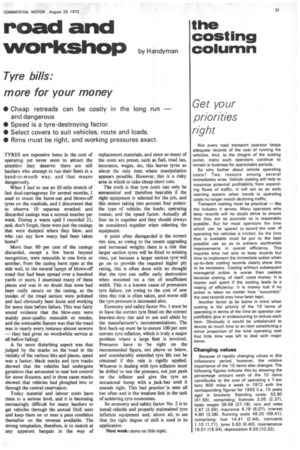road and workshop
Page 33

If you've noticed an error in this article please click here to report it so we can fix it.
Tyre bills: m ore for your money
• Cheap retreads can be costly in the long run and dangerous • Speed is a tyre-destroying factor.
• Select covers to suit vehicles, route and loads.
• Rims must be right, and working pressures exact. by HOndyman
TYRES are expensive items in the cost of operating yet never seem to attract the attention they deserve: there are still hauliers who attempt to run their fleets in a hand-to-mouth way, and that means dangerously.
When I had to use an 85-mile stretch of fast dual-carriageway for several months, I used to count the burnt-out and blown-off tyres on the roadside, and I discovered that to observe 10 separate wrecked and discarded casings was a normal number per week. During a warm spell I recorded 21, , and, don't forget, these were just the casings that were dumped where they blew, and who can say how many had been taken home?
More than 80 per cent of the casings discarded, except a few burnt beyond recognition, were remoulds in one form or another, from the casing burst open at the side wall, to the several lumps of blown-off tread that had been spread over a hundred yards or more. I examined many of these pieces and was in no doubt that none had been really secure on the casing, as the insides of the tread section were polished and had obviously been loose and working for some time before failure. This was fairly sound evidence that the blow-outs were mainly poor-quality remoulds or resoles, and the noticeable feature was that the tread was in nearly every instance almost unworn — they had given no worthwhile service at all before failing!
A far more disturbing aspect was that judged by the marks on the 'road in the vicinity of the various bits and pieces, speed was a factor; black marks and tyre tracks showed that the vehicles had undergone gyrations that amounted to near lost control for some distance, and in three cases marks showed that vehicles had ploughed into or through the central reservation.
Today material and labour costs have risen to a serious level, and it is becoming increasingly difficult for many hauliers to get vehicles through the annual DoE tests and keep them on or near a pass condition thereafter on the revenue available. The strong temptation, therefore, is to snatch at any apparent bargain in the way of replacement materials, and since so many of the costs are preset, such as fuel, road tax, insurance, wages, etc, this leaves tyres as about the only item where manipulation appears possible. However, this is a risky area in which to take cheap short cuts.
The truth is that tyre costs can only be economical and therefore bearable if the right equipment is selected for the job, and this means taking into account four points: the type of vehicle; the loads; operating routes; and the speed factor. Actually all four tie in together and they should always be considered together when selecting the equipment.
A point often disregarded is the correct rim size, as owing to the recent upgrading and increased weights there is a risk that larger section tyres will be fitted to existing rims, yet because a larger section tyre, will go on to provide the required higher ply rating, this is often done with no thought that the tyre can suffer early destruction when mounted on a rim of insufficient width_ This is a known cause of premature tyre failure, yet owing to the cost of new rims this risk is often taken, and worse still the tyre pressure is increased also.
Economy and safety factor No. I must be to have the correct tyre fitted on the correct heaviest-duty rim and to use and abide by the manufacturer's recommendations. The first back-up must be to ensure 100 per cent correct tyre inflation, which is truly a major problem where a large fleet is involved. Pressures have to be right on the' recommended figure, not above or below, and considerably extended tyre life can be obtained if this rule is rigidly applied. Whoever is dealing with tyre inflation must be drilled to test the pressure, not just push on the inflator and give the tyre an occasional bump with a jack-bar until it sounds right. This bad practice-is seen all too often and is the weakest link'in the task of achieving tyre economies.
So economy and safety factor No. 2 is to install reliable and properly maintained tyre inflation equipment and, above all, to see that the right degree of skill is used in its application.
Next week: more on this topic.




















































































